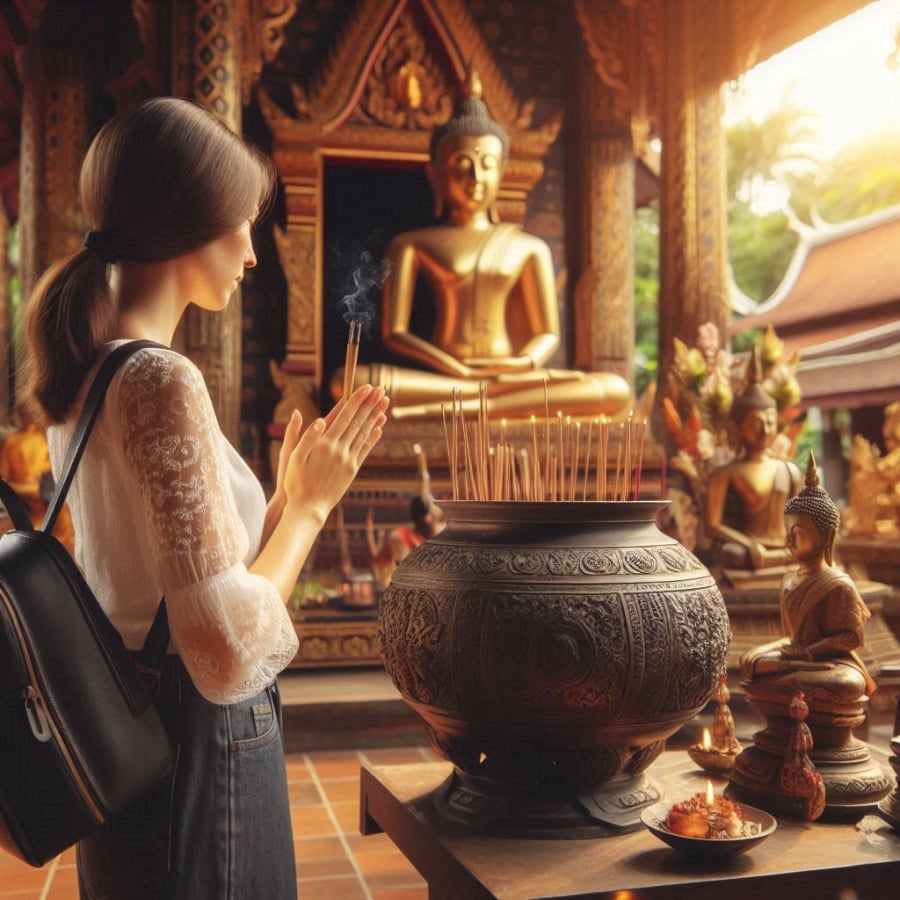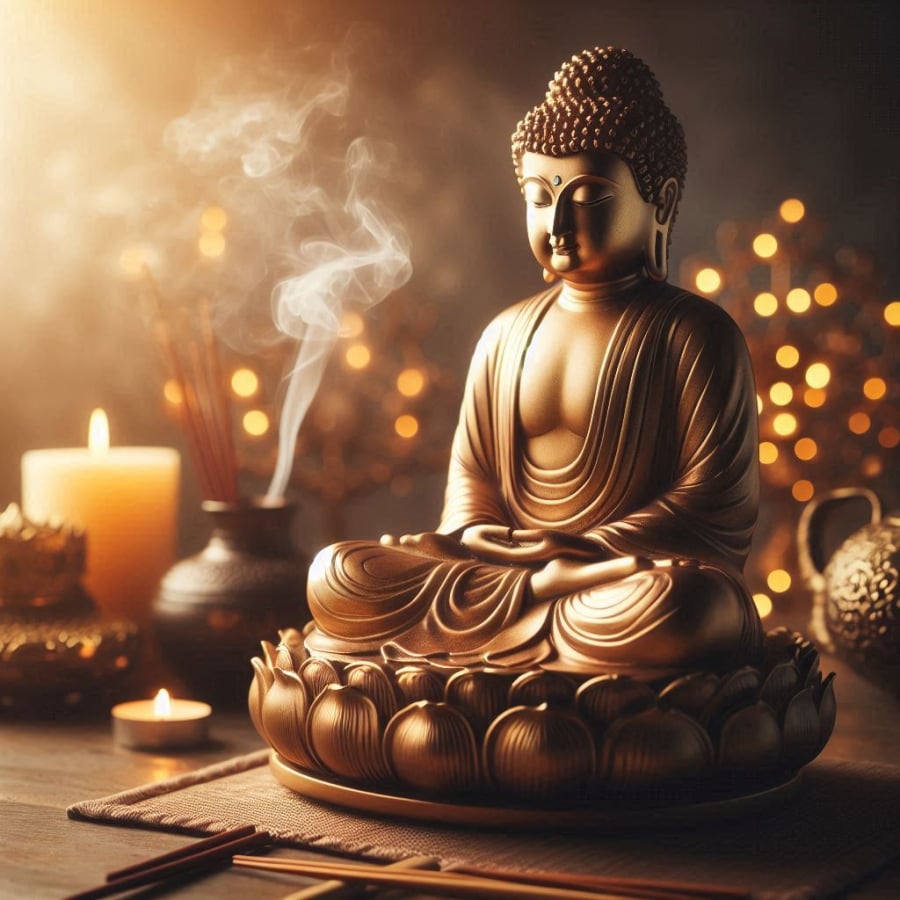Why Do Vietnamese People Often Chant ‘Nam Mo A Di Da Phat’ While Joining Their Palms? What Does This Phrase Mean?
The phrase “Nam Mo” is derived from the Sanskrit word “Namah,” which carries the meanings of reverence, refuge, worship, salvation, and surrender. It conveys the idea of entrusting one’s life to the Buddha.
“A Di Da” is the Vietnamese pronunciation of the Sanskrit word “Amitābha,” which translates to “immeasurable light and life.” It signifies the incredible power of the Buddha of Infinite Light and Life, also known as Amitābha Buddha.
“Phat,” which is the Vietnamese pronunciation of the Sanskrit word “Buddha,” means “enlightenment,” “liberation,” or “freedom from the cycle of birth and death.”
In Mahayana Buddhism, “A Di Da Phat” is the most revered name of a Buddha. Chanting “Nam Mo A Di Da Phat” expresses reverence for the Enlightened One of Infinite Light and Life or signifies taking refuge in this Enlightened Being.

When visiting a temple, most people will join their palms and chant “Nam Mo A Di Da Phat.”
According to the teachings in the Sixteen Sutras, reciting the name of the Amitābha Buddha just once can eradicate the heavy karma of eight million kalpas. Additionally, the sutras state that Amitābha Buddha vowed to guide the souls of those who wholeheartedly chant his name to his Pure Land in the West, also known as the Western Paradise or Sukhavati.
The ritual of joining palms and bowing to the Buddha is called Añjali Mudrā. This gesture is prevalent in Indian beliefs and Buddhism. Hence, you will often see people joining their palms and bowing to the Buddha when visiting a temple. This action demonstrates reverence and is also a form of greeting.
If you observe closely, you may notice that the main officiants at temples, shrines, and communal houses will not join their palms in the same way. Instead, they will cup their hands, forming a circle with their palms facing downward, and place their other hand on top.
The phrase “Nam Mo A Di Da Phat” is reserved for greeting other Buddhists and should only be used when in the presence of the Buddha or at a Buddhist temple. Using this phrase in places dedicated to saints, gods, or other deities is considered inappropriate and meaningless.
Additionally, reciting “Nam Mo A Di Da Phat” at the tombs of kings and lords is considered disrespectful. This is because, in the past, kings and lords were regarded as heavenly sons, or tien tu, believed to be the sons of heaven. Nothing in this world was considered higher than the king, and when worshipping them, one only needed to show reverence to the previous king, or Tien De.
The Legend of Amitābha Buddha
According to the Great Amitābha Sutra, there once was a kingdom ruled by a king named Kieu Thi Ca. After hearing the teachings of a Buddha, the king renounced his throne and became a monk, taking the name Phap Tang. Phap Tang made 48 vows to save sentient beings, one of which was to create a pure land and transform it into one of the most beautiful and serene kingdoms. He also vowed that those who focused their minds on him would be guided by him to this pure land.

Amitābha Buddha is one of the most well-known Buddhas in Mahayana Buddhism.
Phap Tang eventually fulfilled his great vow and became known as Amitābha Buddha. Buddhists envision this pure land as the Western Paradise or Sukhavati, a place of ultimate bliss and tranquility.
In temples, you will find statues of Amitābha Buddha, either standing or seated on a lotus throne. The Buddha is typically depicted with a compassionate smile, a mark on his forehead, and a wide opening on his chest, adorned with the Vajra (a symbol representing indestructibility and spirituality) and an urna (a curled white hair said to represent wisdom and spiritual power). He is draped in a kasaya (a monastic robe) which is often red in colored statues.
In the standing position, his right hand is raised to shoulder height, pointing up, while his left hand is placed at waist level, pointing down. Both palms face forward, and the thumbs and forefingers of both hands form circles by touching.
When seated, the Buddha assumes the lotus position, with his hands in the meditation mudra—one hand resting on top of the other, right over left, with the thumbs touching. The Buddha may also be depicted holding a bowl.
Accompanying the statue of Amitābha Buddha on either side are two Bodhisattvas: Quan The Am Bodhisattva on the left, holding a willow branch and a vase of cam lo (nectar of sweetness and satisfaction), and Dai The Chi Bodhisattva on the right, holding a blue lotus flower.
This information is for reference and contemplation only.
Who is Samantabhadra Bodhisattva? The Feng Shui Significance of Samantabhadra Bodhisattva
The Bodhisattva Samantabhadra is a well-known figure in Mahayana Buddhism. He is revered for his profound wisdom and compassion, often depicted as a majestic deity riding on a white elephant. Samantabhadra’s name translates to “Universal Worthy,” reflecting his all-encompassing nature and his ability to manifest in various forms to guide and assist sentient beings. In Feng Shui, Samantabhadra is associated with wisdom, compassion, and protection. Placing his image in your home or workplace is believed to invite positive energy, enhance spiritual growth, and bring harmony and prosperity to your life. Learn more about the significance of Samantabhadra Bodhisattva and how he can be incorporated into Feng Shui practices to create a harmonious and blessed living environment.
The Ultimate Guide to Invoking the Three Jewels: A Step-by-Step Guide to the Perfect Ceremony in 2023
“The Three Jewels: Unlocking the Heart of Buddhism.
Delve into the profound concept of the Three Jewels, the cornerstone of Buddhist practice. The Buddha, the enlightened teacher; the Dharma, his timeless teachings; and the Sangha, the compassionate community—together they form the sacred triad that guides seekers towards enlightenment and liberation.
This article will serve as your comprehensive guide to understanding the significance of the Three Jewels and their role in Buddhist worship and practice, providing you with a deeper connection to this ancient and profound philosophy.”



































